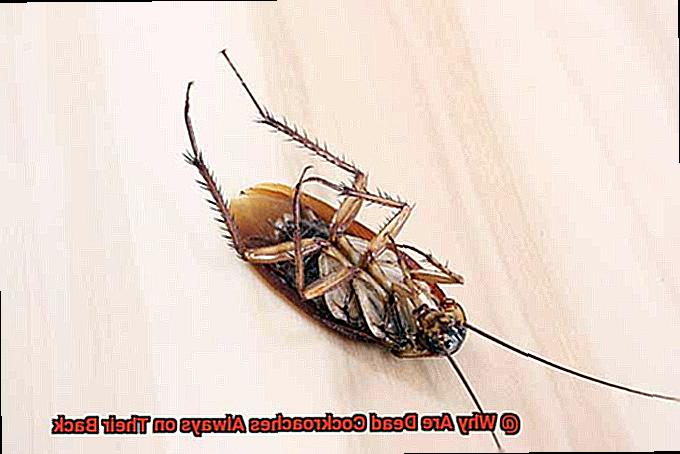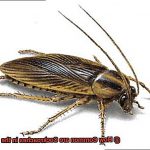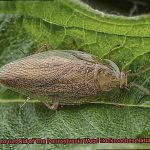Cockroaches, the ultimate survivors and scavengers, are often viewed as the epitome of filth and disease. And nothing is more unsettling than coming across a dead cockroach lying on its back. It’s a common sight that raises an intriguing question: why are dead cockroaches always on their backs?
The answer might surprise you, but it’s not as complicated as you might think. In this blog post, we’ll take a deep dive into the anatomy of these creepy crawlies to understand how their body structure affects their position after death. We’ll also explore the role of gravity and decomposition in determining their orientation.
But that’s not all – we’ll also examine whether this phenomenon has any evolutionary significance for these resilient insects. So buckle up and join us on this fascinating journey into the world of cockroaches as we uncover the secrets behind this bizarre aspect of their death.
What are Cockroaches?
Contents
As members of the Blattidae family, cockroaches are easily recognized by their flattened body, six legs, two antennae, and wings that rest flat over their back. While they come in various sizes and colors, most commonly, they are brown or black.

Cockroaches are creatures of the night, preferring dark and humid environments such as kitchens, bathrooms, basements, and other damp areas. They hide in cracks and crevices during the day and come out at night to scavenge for food. These omnivorous insects can eat almost anything from leftover food scraps to paper products, glue, and even fecal matter. In fact, cockroaches can survive for weeks without food or water.
One of the most fascinating facts about cockroaches is their ability to reproduce quickly. Female cockroaches can lay up to 50 eggs at a time, and the eggs hatch within a few weeks. As a result, a single cockroach infestation can quickly become a full-blown problem if not addressed promptly.
But what happens when a cockroach dies? You may have noticed that dead cockroaches are often found lying on their backs. This is due to several reasons. Firstly, cockroaches have a hard exoskeleton that provides protection and support for their internal organs. When a cockroach dies, its legs and antennae may curl up due to the loss of muscle control, causing it to flip over onto its back.

Additionally, when a cockroach dies, its body starts to lose moisture and dry out. This can cause the exoskeleton to shrink, which can also contribute to the roach flipping onto its back. Another reason why dead cockroaches may be found on their backs is related to their respiratory system. Cockroaches breathe through small openings called spiracles located on their abdomen. When a roach dies, its muscles relax, and its body becomes flaccid, causing the abdomen to expand and put pressure on the spiracles, making it difficult for the roach to breathe.
The Exoskeleton and Muscles
These tiny creatures possess a suit of armor-like exoskeleton made up of chitin, which is one of the toughest substances found in nature. This exoskeleton serves to protect the cockroach’s body from harm and works in unison with the insect’s powerful muscles to provide support.
However, when a cockroach dies, its muscles cease to function, causing its exoskeleton to become rigid. This rigidity, combined with the weight of the insect’s body, causes it to roll over onto its back. The legs and antennae, which were once flexible and pointed downwards, become stiff and point upwards due to the lack of tension in the inactive muscles.
Moreover, the shape of the cockroach’s exoskeleton exacerbates its inability to right itself. As the muscles stop working, the weight of the body causes it to curve towards the ground. This curved shape makes it nearly impossible for the cockroach to regain its upright position.
The next time you come across a dead cockroach on its back, remember that there is a reason behind its peculiar position. It is all thanks to this remarkable combination of a rigid exoskeleton and inactive muscles.
Loss of Moisture and Shrinking Exoskeleton
Well, it all boils down to the loss of moisture in their bodies and the subsequent shrinking of their exoskeletons.
Let’s dive deeper into the cockroach’s exoskeleton. This tough outer shell is constructed from chitin, providing structural support and protection for the cockroach’s vital organs, muscles, and limbs. However, when a cockroach dies, its muscles cease to function, and its weight presses down on its exoskeleton, causing it to curve inwards.
The loss of moisture through evaporation exacerbates this inward curvature, causing the exoskeleton to contract and tighten around the body. Consequently, the legs and wings may curl inwards towards the body, making it difficult for the cockroach to flip over if it falls on its back.
Moreover, this shrinking exoskeleton can cause involuntary muscle contractions that lead to jerky movements, hindering any attempts to right itself. However, it’s worth noting that not all dead cockroaches end up on their backs. Factors such as momentum and surroundings can influence their position upon death.
Understanding this phenomenon can help identify areas where cockroaches may be present. If you frequently find dead cockroaches on their backs in certain regions of your home or business premises, it may indicate an infestation. Taking prompt action to eliminate these unwanted guests can prevent further damage and contamination.
Respiratory System and Pressure on Spiracles
When a cockroach dies, its exoskeleton hardens, making it challenging for the insect to turn over onto its legs or abdomen. However, there is another reason why dead cockroaches are always found on their backs – their unique respiratory system.
Cockroaches have tiny holes called spiracles located on their abdomen that allow them to breathe. These spiracles are connected to tracheae, which deliver oxygen directly to the cockroach’s cells. But when a cockroach dies, its muscles relax, causing the body to collapse and forcing the spiracles to close. With the spiracles closed, the supply of oxygen to the cockroach’s cells gets cut off, leading to its eventual death.
As the spiracles close, the pressure inside the tracheae increases, causing gas to escape from the body through the mouth and anus. This gas release causes the body to arch slightly backward, pulling the legs and wings off the ground and leaving the cockroach in an inverted position on its back.
In other words, a dead cockroach becomes like a deflating balloon where gas escapes from its body, causing it to tip over onto its back and remain in that position.
Now that we understand this phenomenon, it is crucial for homeowners to take preventative measures against cockroach infestations and dispose of dead insects appropriately. Keeping your home clean and free of food debris can discourage cockroaches from finding their way into your living space. Additionally, disposing of dead cockroaches properly can prevent attracting more pests.
Other Insects Found in the Same Position
It’s quite common to find insects in this position after they have passed on. Interestingly, this phenomenon isn’t unique to cockroaches. In fact, beetles, ants, and flies are a few other insects that can be found in the same position.
Now, you might be wondering why insects tend to end up on their backs after death. One explanation is muscle spasms. When an insect dies, its muscles may contract and spasm, causing it to flip over onto its back. Think of it like when you get a cramp in your leg and have to stretch it out to ease the pain.
Another reason could be related to the way insects breathe. As insects breathe through a series of tubes called tracheae, which run along their bodies and connect to tiny holes called spiracles, when they die, these tubes and spiracles may become blocked or clogged. This blockage causes the insect’s body to expand and flip over onto its back. Consider it like when you hold your breath underwater for too long, and your body starts floating to the surface.
It’s worth noting that discovering dead insects on their backs isn’t necessarily an indication that they died from natural causes. They may have been killed by predators or pesticides and left in this position. Therefore, it’s crucial to investigate the cause of death before concluding that muscle spasms or tracheal blockages were solely responsible for the insect’s position.
VkUstEAThxU” >
Conclusion
In conclusion, the reason why dead cockroaches are always found on their backs is not a mysterious occurrence. It’s simply due to the anatomy and physiology of these insects. Cockroaches have a tough exoskeleton that supports and protects their internal organs. When they die, their legs and antennae may curl up, causing them to flip over onto their backs due to loss of muscle control. Additionally, as their bodies dry out, the exoskeleton shrinks, contributing to the roach flipping over.
Understanding this phenomenon can help identify areas where cockroaches may be present. If you frequently find dead cockroaches on their backs in certain regions of your home or business premises, it may indicate an infestation. Taking prompt action to eliminate these unwanted guests can prevent further damage and contamination.
It’s worth noting that other insects such as beetles, ants, and flies can also be found in this position after death. The reasons behind this phenomenon vary from muscle spasms to tracheal blockages.
In summary, discovering dead cockroaches on their backs may be unsettling for some people but it’s a natural occurrence based on the insect’s biology.






